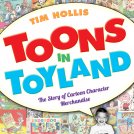 Toons in Toyland is the Story of Cartoon Character Merchandise. The author talks about the toys he had as a kid and that he tried to buy back many of the toys he had as a kid that were donated by his parents in order to get his collection back again and house it in a museum. The book talks about the history of toys made in the likeness of cartoon characters and throughout the book are photographs of the various toys. It’s fun to see how some of the older toys look compared to who they were supposed to be (in particular there is a photo of a toy of Barney Rubble with green hair!) Even the costumed Disney characters are featured and I have to say I’m glad I wasn’t a kid in the early 60s. Creepy!
Toons in Toyland is the Story of Cartoon Character Merchandise. The author talks about the toys he had as a kid and that he tried to buy back many of the toys he had as a kid that were donated by his parents in order to get his collection back again and house it in a museum. The book talks about the history of toys made in the likeness of cartoon characters and throughout the book are photographs of the various toys. It’s fun to see how some of the older toys look compared to who they were supposed to be (in particular there is a photo of a toy of Barney Rubble with green hair!) Even the costumed Disney characters are featured and I have to say I’m glad I wasn’t a kid in the early 60s. Creepy!
This book was fun to read, with a lot of great information included. (I found out some more about Tim’s museum at roadside america)
About the Book
A look at the massive way cartoons dominated the magic of merchandising
Every living American adult likely prized one childhood toy that featured the happy image of an animated cartoon or comic strip character. There is an ever-growing market for these collectibles, and stacks of books pose as pricing guides. Yet Tim Hollis is the first to examine the entire story of character licensing and merchandising from a historical view.
Toons in Toyland focuses mainly on the post–World War II baby boom years, circa 1946–1980, when the last members of that massive generation were in high school. During those years, the mass merchandising of cartoon characters peaked. However, the concept of licensing cartoon characters for toys, trinkets, and other merchandise dates back to the very first newspaper comics character, the Yellow Kid, who debuted in 1896 and was soon appearing on a variety of items. Eventually, cartoon producers and comic strip artists counted on merchandising as a major part of their revenue stream. It still plays a tremendous role in the success of the Walt Disney Company and many others today.
Chapters examine storybooks (such as Little Golden Books), comic books, records, board games, jigsaw puzzles, optical toys (including View-Master™ and Kenner’s Give-a-Show Projector™), and holiday paraphernalia (Christmas, Halloween, Easter, Valentine’s Day, and birthday party ware). Extending even beyond toys, food companies licensed characters galore—remember the Peanuts characters plugging bread and Dolly Madison snacks? And roadside attractions, amusement parks, campgrounds, and restaurants—think Yogi Bear and Jellystone Park Campgrounds—all bought a bit of cartoon magic to lure the green waves of tourists’ dollars.
Tim Hollis, Birmingham, Alabama, has published twenty-four books on pop culture history. For more than thirty years he has maintained a museum of cartoon-related merchandise in Dora, Alabama. He is the author of Dixie Before Disney: 100 Years of Roadside Fun; Florida’s Miracle Strip: From Redneck Riviera to Emerald Coast; Hi There, Boys and Girls! America’s Local Children’s TV Programs, Ain’t That a Knee Slapper: Rural Comedy in the 20th Century, and, with Greg Ehrbar, Mouse Tracks: The Story of Walt Disney Records, all published by the University Press of Mississippi.